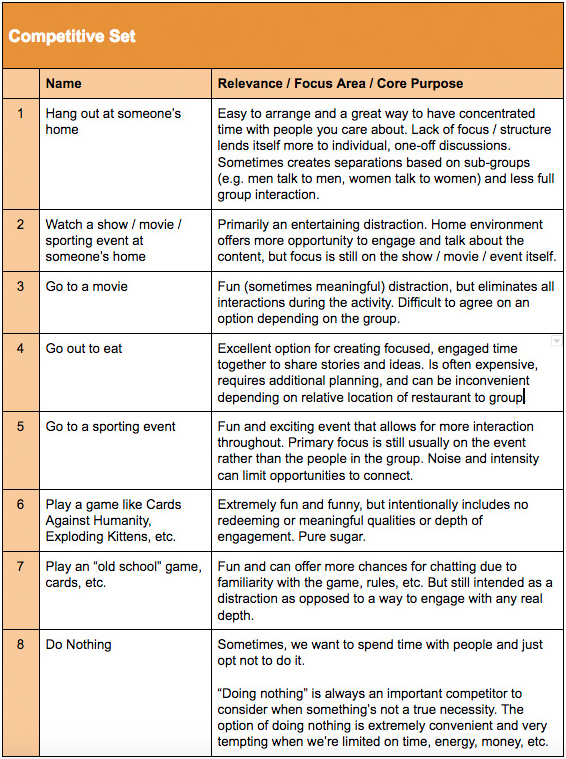
This series follows a real life startup to show how you can craft the strategy and messaging you need to launch your business idea and validate it with customers.
Quick Recap and Context
If you’re just jumping in, this series is designed to walk through a process to define the strategy and messaging for your business using the real life case study of a party game called The Death Deck. If you haven’t read that intro, it would be good to check that out first to get some context:
Read the intro to the series and the origin story of The Death Deck.
The steps being covered in this series are:
- Your Vision
- Your Target Customers’ Jobs
- Your Competition [YOU ARE HERE!]
- Your Offering and Its Features
- Your Tone of Voice and Messaging
If you’re all caught up and ready for the next step, let’s go!
Step 3: Your Competition
This step will help you define:
- What other solutions exist that could address all or parts of your customer’s Job Story
- In what ways are those other solutions positioned to solve the problems of your customers
Why it’s important:
If the Job you defined in the previous step is important for your customers, then they’ll have some way they’re currently addressing it in their lives.
By digging into the competition, it maps out which aspects of this problem your competitors are focused on, and in turn helps you find openings for your solution within that landscape.

It’s also important to consider the competing solutions your customers use because it means in order for them to use your solution, they’ll need to switchfrom whatever they’re doing now.
That may not sound like a big hurdle, but people generally aren’t fans of switching. They much prefer to keep doing what they’re already doing whenever possible.
Switching means expending precious resources like time, effort, and likely money. It also means customers have to admit on some level that a new choice may be better than a past choice. This process can generate cognitive dissonance because it means what‘s been accepted as a satisfying solution now seems less optimal.
To overcome all of that and get customers to switch, your solution needs to offer significantly greater benefits. Some say as much as 10x greater than what the customer is using now.
In a few steps, you’ll see how we can use the differences we identify in competing solutions to shape the messaging for your solution.
Exercise:
Brainstorm some products or services that fulfill the same job that you intend to fulfill for your target customer. Think broadly. Don’t limit yourself to offerings only in the category you believe you’re in.
Here are some examples for The Death Deck, with our selected Job:
“Spend quality time with friends and family”

Key Takeaways:
It’s easy to see how many options are competing for the time and attention of your customers. This process helps you identify the strengths and weaknesses of each so that you can best position your solution within that landscape.
Going back to The Death Deck, it doesn’t have the excitement of a live sporting event, or the over-the-top hilariousness of Cards Against Humanity. On the other hand, it’s a fantastic way to get a group engaged in a fun game environment that also generates real, meaningful discussion and storytelling with the an entire group.
That’s a strong point of differentiation. That’s the type of insight to hold onto as we think about how to get customers excited about using the product.
Ready For More?
In step four, we’ll look at your specific product or service to see how it addresses the Job of your customer in a way that’s unique within the competitive landscape.
This will help you start to see which parts of your offering are most (or least!) important so you can emphasize the right aspects.
Click here to get started on Step 4, Your Offering and Its Features
Need Help?
If you ever get stuck on any of these steps you can get more free resources in our Field Guide.
And if you want help from us personally, you can reach out for a free consultation any time.
If you just want free stuff to help you think about your business in new ways sent to your inbox, sign up below!


